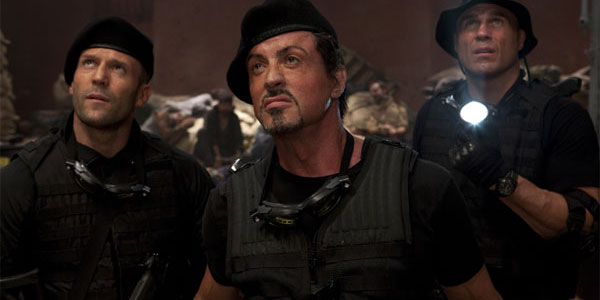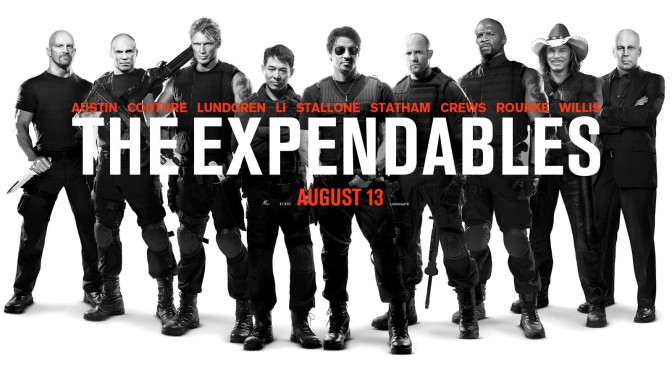I have a strict rule that I won’t cite the best movie stunts for any given year to any film that has had any deaths or serious injuries due to stunts. I don’t believe the production can be deemed a success if any of these occur, even though I do know that sometimes accidents do happen regardless of all the safeguards that are put in place to prevent them. With that in mind there are some productions where there are accidents and the stunt team and performers keep pushing on and in many cases without complaint or even without much Hullaballo…just bandage up and move on. Regardless, those productions usually have a key member on the team that sets such a heavy pace and keeps everyone in grand spirits and moving forward. That in my book is the definition of “heart”. That is what Sylvester Stallone shows his team on this production. Just watch the making of this movie and you will see what a truly tough bastard he is. He’s got heart.
This was a production like no other, as for the first time multiple “action stars” came together to join a team. With different backgrounds, styles, training and experience, it was quite a feat to bring all this together for the stunt team. Overseeing all the stunts were David Leitch and Chad Stahelski, the well-known team of second unit directors and stunt coordinators behind “The Bourne Ultimatum,” “300” and “Mr. & Mrs. Smith.” To that end, the pair assembled a team of two martial arts choreographers and eight other experts from their action design company 87Eleven, “who then worked with the 80 other stunt guys on the film,” Stahelski explains. “It was a huge job.”
Stallone and the others “were very involved in their stunts — especially Stallone, who’s the most hands-on of all. He shows up in workout gear, super-motivated, and he’s very practical in his approach. He wants his fans to see it’s really him in a fight scene, so he will rehearse, but he doesn’t rely on doubles and camera tricks. He wants to do it all himself.” By contrast, Statham is “all about prep,” Stahelski notes. “His background is martial arts. So he likes every move to be meticulously choreographed. … Jason’s a rehearsal nut and he likes working with doubles and stunt guys, and there’s no room for improvisation. It’s all very precise.” Li is “somewhere in the middle,” Stahelski adds. “He loves to prep, but also keep it loose on the set, to suit the environment. And true to his Hong Kong style, he’ll come up with an idea and gradually piece it together, and then change it as needed on the day.”
Stallone’s penchant for improvising within action scenes frequently gave Stahelski “a faint heart,” he admits. “He’ll change the moves on the day, but he does rehearse them first. He doesn’t just make stuff up oncamera, which isn’t safe to do.” Austin, who plays one of the villains, has a slightly different take on it: “Sly improvised a punch to my groin,” he recalls with a laugh. “He didn’t give me a cup-check question first, and I’m damn glad I had one on.”
Stahelski says Stallone “took quite a beating” during production, and suffered multiple injuries, including damaging his neck, head and ankle when he was thrown against a brick wall in a climactic fight scene with Austin. “We shot the scene in an old underground tunnel in New Orleans, and it was very carefully choreographed,” Austin says. “I spent three weeks rehearsing it with Chad and the guys. But on the day, when the fight started off being very technical, Sly just changed it on the spot. He wanted it to be far more brutal and kick-ass, and he kept amping it up, and when the director tells you to kick his ass, you gotta kick his ass.”
The result? “We did a vicious headbutt the moment we started,” Austin says, “and he was bleeding and I had a huge bump on my forehead. And it’s not a good thing to bump heads with your star, as it tends to be your fault. So Chad had to change a few things, and much later, I found out that Stallone had also hurt his neck badly, but he never complained or stopped, and we fought all-out for two days.” The body count escalated from there. “A couple of stunt guys got broken ribs from being thrown into poles, a few had black eyes, there were tons of bruises and ripped skin from rolling around on cement with sand everywhere. And Randy Couture smoked a few guys,” recalls Austin. “It was pretty crazy, as everyone wanted their fight scenes to be the best. When you get a bunch of macho tough guys like this together, no one’s holding back.”
The Expendables was directed by Sylvester Stallone for Millennium Films.
Things to look up (click on item to go to IMDB page or Website):
Sylvester Stallone
Randy Couture
Steve Austin
David Leitch
Chad Stahelski
Jet Li
Jason Statham
Millennium Films
Mexican Standoff as defined by Wikipedia:
A Mexican standoff is a confrontation between at least two parties in which neither party can proceed nor retreat without being exposed to danger. As a result, all participants need to maintain the strategic tension, which remains unresolved until some outside event makes it possible to resolve it. Mexican standoffs need not have only two participants, however. If a standoff involves three or more parties, the tactics for resolving it will be substantially different from those for a duel, where the first to shoot has the advantage. In a confrontation among three mutually hostile participants, the first to shoot is at a tactical disadvantage. If opponent A shoots opponent B, then while so occupied, opponent C can shoot A, thus winning the conflict. Since it is the second opponent to shoot that has the advantage, no one wants to go first. The situation further changes with the degree and type of armament each party possesses; a 3-person Mexican standoff with dual wielded pistols for each party skews the outcome in favor of whomever shoots first, with the presumption that both shots are fired simultaneously, as both opposing parties are eliminated.
In popular usage, the term “Mexican standoff” is sometimes used in reference to confrontations in which neither opponent appears to have a measurable advantage. Historically, commentators have used the term to reference the Soviet Union – United States nuclear confrontation during the Cold War, specifically the Cuban Missile Crisis of 1962. The key element that makes such situations “Mexican standoffs” is the equality of power exercised among the involved parties. The inability of any particular party to advance its position safely is a condition common among all standoffs; in a “Mexican standoff,” however, there is an additional disadvantage: no party has a safe way towithdraw from its position, thus making the standoff effectively permanent.
In financial circles, the Mexican standoff is typically used to connote a situation where one side wants something, a concession of some sort, and is offering nothing of value. When the other side sees no value in agreeing to any changes, they refuse to negotiate. Although both sides may benefit from the change, neither side can agree to adequate compensation for agreeing to the change, and nothing is accomplished.
The Mexican standoff is now considered a movie cliché stemming from its frequent use as a plot device in cinema.

